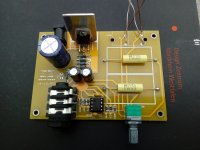Almost finished this grado clone pcb and I need advice how to calculate pot for this amp. I installed gold plated socket for njm4556ad, gold plated output socket, little wima's and elnas plus two ecwfe 2,2uf mkp input caps.
Resistors also have sockets so I can change gain if I need to but pot will be soldered in so I need to pick ideal value to cover multiple gain options (if pot ever have any influence on that). Thanks 🙂

I have chosen 47K at R1 and 22K at R2 and R3 which is about 4dB gain.
Resistors also have sockets so I can change gain if I need to but pot will be soldered in so I need to pick ideal value to cover multiple gain options (if pot ever have any influence on that). Thanks 🙂

I have chosen 47K at R1 and 22K at R2 and R3 which is about 4dB gain.
Last edited:
1. This is a noninverting amplifier circuit. Dominant concerns in choice of pot are desired minimum input impedance, noise (the 4556A isn't low-noise so that's not too critical) and opamp input impedance distortion (probably not a major concern). Also quality / channel tracking - for some reason this seems to favor the higher-impedance parts. In all likelihood anything from 10k to 100k would be fine, with 50k being a common choice. You can then choose an input bias resistor to match (should be a fair bit larger than Rpot / 4, so anything beyond 100k is not likely to be necessary).
2. Looks like part numbering on this board is nonstandard. I'd guess R1 / R2 are L / R input bias resistors to ground, and R3 / R4 (x2 for L + R) are the gain-setting resistors. Trace out a channel to verify, using existing RA-1 clone schematics as guidance.
3. R3 || R4 should be between about Rpot / 30 and Rpot / 4 (depending on likely volume setting), so 22k each would still be OK with a 50k or 100k pot but may be a bit on the high side. I would suggest more like 4k7..10k.
2. Looks like part numbering on this board is nonstandard. I'd guess R1 / R2 are L / R input bias resistors to ground, and R3 / R4 (x2 for L + R) are the gain-setting resistors. Trace out a channel to verify, using existing RA-1 clone schematics as guidance.
3. R3 || R4 should be between about Rpot / 30 and Rpot / 4 (depending on likely volume setting), so 22k each would still be OK with a 50k or 100k pot but may be a bit on the high side. I would suggest more like 4k7..10k.
Last edited:
On this Zero Zone clone RA1 board I used 50k pot. Since it was difficult to find log pot with suitable footprint, I used 50k linear pot that I had. To my surprise linear pot works just fine with high impedance headphones that I have (Sennheiser HD424 and AKG K141 monitor). Only with 32 Ohm headphones lin pot is too sensitive and gives too high level at low volume settings.
Out of curiosity I put ordinary general purpose RC4558 opamp in the socket instead of NJM4556A and it sounds very good indeed. I would not recommend ordinary general purpose opamp for low impedance headphones, but with 600 and 2000 Ohms it's just fine. One thing that I noticed with NJM4556A is that it sounds better with +/-12VDC supplies than with +/-9VDC, although most industrial makers usually use 9V.
Out of curiosity I put ordinary general purpose RC4558 opamp in the socket instead of NJM4556A and it sounds very good indeed. I would not recommend ordinary general purpose opamp for low impedance headphones, but with 600 and 2000 Ohms it's just fine. One thing that I noticed with NJM4556A is that it sounds better with +/-12VDC supplies than with +/-9VDC, although most industrial makers usually use 9V.
Attachments
One thing I also noticed is that original Grado RA1 uses ordinary ALPS RK16 carbon pot and clone board from post no.1 has footprint for ALPS RK27 aka Blue Velvet. If you want to emulate the sound of original product I advise to use RK16 pot. It's cheaper, does not have specs of Blue Velvet but will sound more open and bright. With Blue Velvet the sound will be softer and darker, which I do not like.


